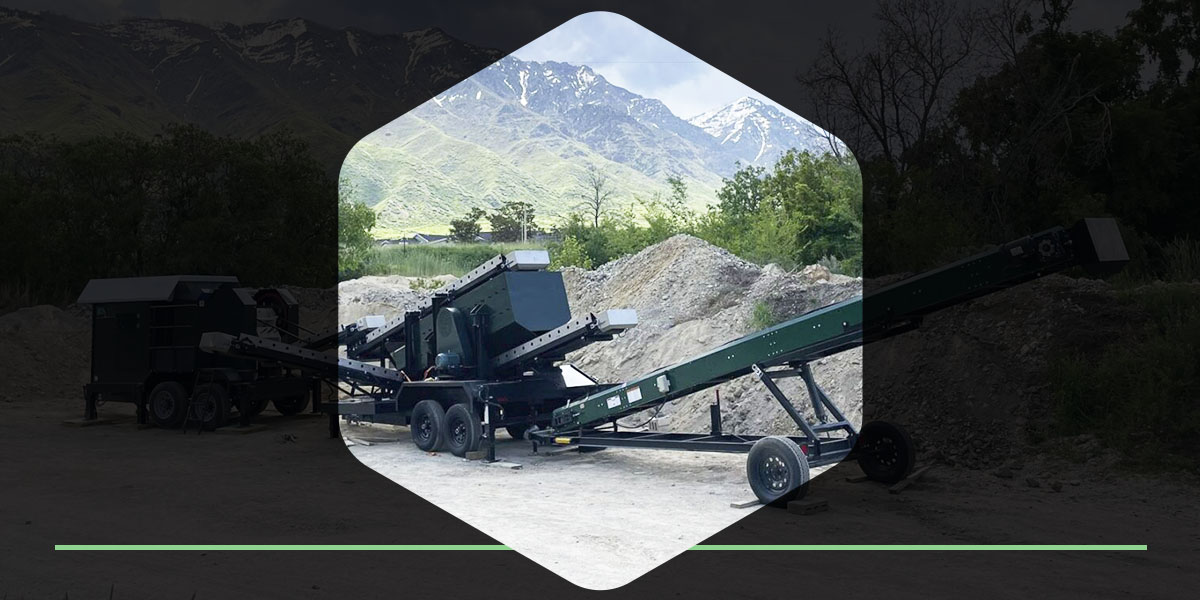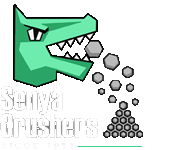
If you want to ramp up aggregate processing, you should invest in a screen plant. Many different industries use aggregate as an essential part of their work. However, each industry has its own requirements and specifications for aggregate size and characteristics.
A screen plant can help you quickly sort crushed aggregate into several different sizes. It saves you time while improving the quality of your product. It can help you reach new industries, reduce waste and ultimately grow your profit. Learn more about the benefits of screen plants for aggregate and how to choose the right screening equipment for you.
What Are Screen Plants and How Do They Work?
Screen plants use gravity, vibration and various filters to sift aggregate into piles of different-sized material. Larger filters sit on top, separating pebbles from finer aggregate and dust, known as the “minus” in an aggregate size. As material moves down through the filters, it becomes finer and finer until the smallest screen size is left along with the “minus”.
Here’s the working principle of a screen plant showing a two-deck screen plant sorting three sizes. Multiple deck screen plants are available to sort even more sizes at once:
The filters in this equipment are called “screens,” and you can get these screens in many different sizes depending on the material type you want to separate. While some screen plants have you load aggregate right on top of the first screen, others are built with a conveyor that carries material onto the top screen.
As aggregate processes through each screen, it’s sent by conveyor to a separate location, so each material size creates its own pile. Once the sorting process is finished, you’ll have several piles of aggregate in different sizes, all neatly separated to create a refined, high-quality product.
Benefits of Screening Aggregate Material
Although you can run an aggregate processing company without a screen plant, your final product won’t be as refined. This can negatively impact sales and lead to waste. When you add screening to your process, it will benefit your business in many ways. Here are the top five advantages to consider:
Elevates Material Quality
A screening plant ensures your products are consistent and also “clean”. Although you can use different crushers and manual sorting such as a grizzly to control aggregate characteristics, using a screen will elevate your material quality. Screened products are more desirable for many clients who rely on tight aggregate specs to complete specific and important tasks. Some jobs, such as gravelling roads, can benefit from the fines being in the mix of aggegate as they help set the material and over timie can make almost as hard as asphalt even. Other job specs require a certain minimum percentage of “fines”, the sizes smaller than the desired size for the majority of the material to meet the requirements of the job. In most cases, screened “clean” material of consistent size with minimal to no fines can be worth considerably more adding greatly to your operations profitability.
Ensures Industry Compliance
Some industries have strict compliance standards for aggregate to ensure the safety of their products. When you screen your product, you can assure them of the quality they need to meet compliance standards. This can open up a new customer base, allowing you to reach more companies with a better product.
Increases Project Efficiency
When you start screening aggregate with a plant, it will save you a lot of time. Every time you have to manually touch the material with a machine costs your operation money. Crushing in different sizes or manual sorting isn’t nearly as efficient as a screen plant. When you invest in a plant, you can sort different sizes of aggregate simultaneously, creating multiple products with a single quick processing step.
Expands Industry Applications
Another benefit of screening material is expanding your product line and reaching new industries. If you upgrade your operation with a screen plant, you can refine crushed material into multiple piles of consistently sized material. Instead of product waste, you’ll have new types of products that can expand your customer base.
For example, larger aggregate in the 2-3″ range is desirable to put down on the entrance to construction sites where the big trucks are in and out all day and a more robust size is needed. The most in demand size is the 1-1.5″ “crush and run” used to gravel roads as well as a standard base underneath every concrete pour. Smaller 5/8″- ¾” material is used as backfill as well as around drainage and electrical lines as the smaller size allows it to pack more tightly for a stronger fill.
The ability to offer multiple sizes of screened material can help you satisfy all of your customers aggregate needs. Custom screen sizes are also available for the desired application and even type of material. Screen plants can also be used on topsoil and mulch increasing their value as well. Glass recyclers can even use screen plants to separate the glass from trash as well as remove plastic from the glass. Outdoor shooting ranges are even required to remove the lead bullets from their soil per EPA standards and screen plants can be a great solution. The applications for a screen plant can be widespread across many industries.
Grows Your Profit

By investing in a screen plant, you can significantly grow your operation, customer base, and profit. Your product will be of higher quality, reach compliance specs for more industries and be sorted more efficiently, all of which dramatically increases your material value and operational profit. Screen plants will also help you reduce waste, reaching more industries and offering a higher return for the material you process.
How to Choose the Right Screen Plant
Before you choose a screen plant, you should consider the different types available. Not every screen plant offers the same result, with some types being a better fit depending on your material, location and other priorities such as tons per hour processing capability. Here’s more about common screen plant types so you can find the best option for your operation.
Stationary vs. Mobile Screen Plants
As their name suggests, stationary screen plants are built to stay in one location. They’re often used in quarries and recycling plants because they’re low maintenance and can process a lot of material quickly. If you need to separate aggregate in a single location, a stationary screen plant could be the best fit for you.
If you’d like a screen plant that can travel with you to different jobsites, a mobile plant is a better option. These plants are a good choice for construction and mining sites that require frequent moves. Mobile or portable screen plants versatility can make them a good investment for aggregate operations. As always, processing on site and removing the transportation costs can dramatically reduce your operation costs.
Incline vs. Horizontal Screens
Incline and horizontal screens are both commonly used for screen plants. The primary difference between them is their angle to the ground — incline screens are tilted, while horizontal screens are parallel to the ground. Both types of screens have pros and cons:
- Incline screens: Material moves quickly due to gravity and vibration. These screens can handle a large volume of aggregate and work well for sticky materials. However, they take up more space and aren’t as effective for extremely fine materials.
- Horizontal screens: This kind of screen uses vibration to separate materials. It takes up less space and screens very fine materials effectively because of its slower material flow. However, it’s not as effective for sticky materials like clay.
How much material do you need to process, to what size, and what is its consistency? Answering these questions can help you decide on the best type of screen for processing aggregate at your operation.
Wet vs. Dry Screening
Adding water to aggregate reduces dust and can create a cleaner final product once the material is passed through screens. It’s a good choice for aggregate that’s already sticky or wet, like clay. Some applications, such as some specific concrete mix requirements necessary for strength, can even require washed material. However, wet screening is considerably more expensive than dry screening and it’s not always easy to access enough water to process materials this way.
Dry screening, on the other hand, separates aggregate without getting it wet first. It organizes materials by size and is much less expensive than wet screening. Dry equipment also lasts longer, since there’s less potential for corrosion. Although it’s easier, dry screening does create more dust and doesn’t clean material for job specs as thoroughly as wet screening.
How Much Do Screen Plants Cost?
The cost of screen plants varies depending on type, size and specific features. However, these machines tend to pay for themselves quickly because they bring so much value to an aggregate operation.
To get the highest ROI for a screen plant, do your research and choose one that fits your needs. You should investigate which plant and screens are best for your material type. Then, go with a company known for machine quality and excellent customer service.
Many screen plant companies understand that the initial investment can be challenging for small to mid-sized aggregate companies. They often have financing plans to help you navigate the cost and benefits of your crushing operation and make this equipment more accessible. Once you own a screen plant, you can put it to work to improve product quality and increase long-term profits. Most always, when you compare your monthly payment on a screen plant to the added income it can provide to your material processing operation, the decision to own a screen plant can be an easy one!
Upgrade Your Operation With a MICRO Screen Plant From Senya Crushers
At Senya Crushers, we’ve been supporting the aggregate industry with crusher equipment since 2004. Today, we offer a range of crushers, conveyors, stackers and screen plants to support processing needs for small to mid-sized processing companies. We’re passionate about helping you succeed in the processing industry!
Senya Crusher’s MICRO screen plant is portable, made in the USA and simultaneously sorts three sizes of aggregate. Custom screen sizes are available from 3″ down to even 1/8″ and are easily swapped out. It can produce up to 400-600 tons per day and can be run by a single operator. Our machines are built on a Department of Transportation (DOT)-approved and VIN’d trailer and can easily be pulled with a pickup truck for maximum mobility. It can also be run off the power plant of your Senya Crusher so no additional power source is required. The Senya SP1 MICRO Screen Plant is a crucial part of our entire MICRO Plant, the only “portable quarry on wheels” easily mobilized with pickup trucks in the world!
A Senya MICRO screen plant can be a game-changer for your business, significantly improving your profits by elevating your product quality and helping you stand out in the market. Fill out a contact form to learn more and hear about our financing options!








